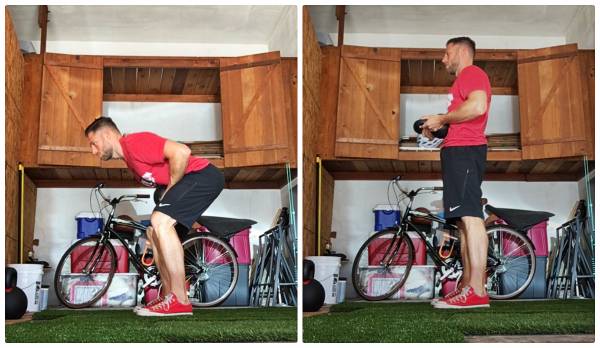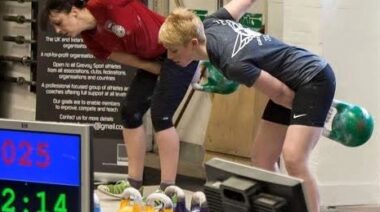As I wrote in my last article, the kettlebell swing is one of those bang-for-your-buck exercises that touches on the important aspects of strength and endurance. While it’s a tremendous exercise and scalable for just about anyone, it does have a learning curve. Today I’ll discuss the common problems I see most people encounter when first learning how to swing a kettlebell, and discuss three exercises that will help you become a better swinger.
These exercises are great at correcting some of the more common problems people have with the kettlebell swing. [Photo credit: Shutterstock]
Exercise 1: The Static Stomp Deadlift
Problem: Whole body soft lockout
A soft lockout at the top of the swing is common with beginners who aren’t familiar with the skill of creating tension, but can also be found in stronger men and women who are just being lazy. They’ll swing the bell up using their arms and have very little pop—if any—coming from the hips. To correct this issue, there has to be a general idea of what tension is and where you need to create it.
To fix this problem I like to use the static stomp deadlift, which is one rep of the deadlift using a kettlebell. At the top of the movement, the student holds the bell in lockout for roughly five seconds. While in the lockout position, the idea is to trigger tension throughout the entire body. Here’s how I teach that tension in the lockout:
- Drive your feet through the floor.
- Pull your kneecaps up towards your hips.
- Squeeze your glutes.
- Brace your abs for a punch.
- Pinch pencils under your armpits.
- Scan one more time, making sure to get tighter and tighter.
- Smile.
This should be challenging and somewhat tiring, which is why you only hold for five seconds. However, at no point should you become tense above the shoulders, hence the cue to smile. After each a rep of the static stomp, shake out the tension. This is effective because you now have tension to release, and thus can notice when your muscles become loose.
The static stomp represents the top of your deadlift, the top of your squat, and the top of your swing. After a couple rounds of the static stomp, you will create noticeably more tension, and your swings start to look more and more crisp.
Exercise 2: Belly Swings
Problem: Soft lockout above the waist
Lack of tension in the core is an issue for many athletes, regardless of strength or experience. The only downside to the static stomp is that, as the name implies, it’s a static lift. When you start swinging a kettlebell, it’s more difficult to put the timing of tension and relaxation together.
One solution is pairing the static stomp deadlift with rounds of belly swings. The belly swing is essentially “swinging” without swinging. Grab a light bell, flip it on its side, and press it into your stomach in order to cue abdominal tension. Then fight the force of the bell driving into your stomach by pushing your stomach into the bell. This should create a relatively strong isometric contraction throughout your core.

[Collage credit: Chris Abbott]
Once you’re in position, perform swings as usual. Pairing belly swings with the static stomp deadlift will fine tune your swing to a much greater degree.
Exercise 3: The Air Swing
Problem: Breaking your lockout too soon
Another common issue I see is breaking the lockout too soon and rushing the bell on the way down. The air swing is a great exercise to improve the timing and tempo of the swing. This drill can also highlight and correct the arms coming up before the hips and legs lock out. Going slowly through the entire swing without a bell teaches you to be patient, which is difficult for most people.
As you may have guessed, this exercise is un-weighted. Assume your starting position. Sometimes it helps to have a bell in front of you to visualize swinging a bell. Then slowly go through the mechanics of the swing:
- Hike the imaginary bell.
- Maintain contact with the upper arms against the rib cage.
- Drive forcefully into the ground (but still slowly).
- Lock out your hips.
- Your arms should become detached from your ribs and float up with the bell.
- Pause for a second.
- Hold your lockout as your arms start to come down.
- Once your upper arms come in contact with your rib cage, then you break your lockout.
Make Your Swing Solid
The static stomp deadlift is great for helping you learn how to create maximal tension at the top of your lockout. The belly swing will help you create tension at the core while performing the swing motion, and the air swing will help give you the rhythm and timing of your swing. Individually, these three exercises are great at correcting some of the more common problems people have with the kettlebell swing. Combined, they’ll take your swing to another level, which in turn will increase your strength, power, and endurance.
More on improving your kettlebell technique:






